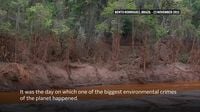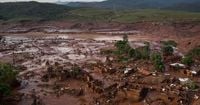A decade has passed since one of Brazil’s worst environmental disasters, but for the Indigenous Krenak people and many others living along the Doce River, the wounds remain fresh and justice elusive. On November 5, 2015, a mining dam owned by Samarco—a joint venture between Brazilian mining giant Vale and Anglo-Australian powerhouse BHP Billiton—collapsed near the town of Mariana in Minas Gerais. The catastrophe unleashed an estimated 40 million tons of toxic iron ore waste, killing 19 people, burying the community of Bento Rodrigues, and contaminating nearly 600 kilometers (about 370 miles) of waterways before the pollution reached the Atlantic Ocean. The event, which the Krenak now call “the death of the river,” marked a turning point for the region and for Brazil’s environmental legacy.
According to the Associated Press, the signs of impending disaster were felt by the Krenak people even before the dam broke. “A week before what the Indigenous Krenak people now call ‘the death of the river,’ they say they could feel it coming. The birds stopped singing, the air grew heavy, and an unusual silence settled over their village in Minas Gerais,” reported AP. For generations, the Krenak had relied on the Doce River for food, rituals, and daily life, making the loss both an environmental and a spiritual tragedy. As Shirley Djukurnã Krenak, an Indigenous leader, told the AP, “It was the saddest day for my people. We felt the death of the river before it arrived.”
The environmental impact was immediate and devastating. The Doce River, one of Brazil’s most ancient and significant river systems, was transformed overnight from a source of life to a symbol of loss. The mud and mining waste swept downstream, poisoning the water, killing fish, and leaving communities without clean water or a way of life. Even now, ten years later, the river remains contaminated by heavy metals, and the people who depended on it continue to suffer the consequences.
Despite the magnitude of the disaster, the road to recovery has been long and fraught with setbacks. Reconstruction and reparations have dragged on through protracted legal battles. In October 2024, Brazil’s federal government, along with the states of Minas Gerais and Espirito Santo, signed a massive 132 billion-reais ($23 billion) settlement with Samarco and its owners, bringing the total payments to a staggering 170 billion-reais ($30 billion). The deal was intended to fund social and environmental repairs for the affected communities. Yet, as critics point out, the money cannot undo the damage that has been done, nor can it restore the river to its former health.
“The Mariana disaster showed how fragile Brazil’s system of environmental control really is,” said Maurício Guetta, legal policy director at the advocacy group Avaaz, in comments to the Associated Press. He argued that rather than strengthening protections in the wake of the disaster, Brazil has moved in the opposite direction. “Instead of learning from it, we’ve seen a process of deregulation.”
Indeed, the years since the Mariana collapse have seen a series of controversial policy changes. After the 2015 disaster, the state of Minas Gerais weakened its environmental licensing laws—a decision many experts believe paved the way for the Brumadinho dam disaster in 2019, which killed 270 people. More recently, Brazil’s Congress has passed laws that restrict Indigenous land claims and relax environmental licensing. In 2023, a law was approved that placed new limitations on the ability of Indigenous peoples to reclaim ancestral lands. This year, another bill—dubbed the “devastation bill” by activists—was passed, further loosening environmental oversight nationwide.
Environmentalists warn that these legislative changes threaten to undermine Brazil’s own climate goals under the Paris Agreement, the landmark 2015 global pact aimed at reducing greenhouse gas emissions and limiting global warming. Guetta told the AP that Congress is currently considering yet another bill that would “practically dismantle Brazil’s environmental licensing system,” making it even easier for mining and industrial projects to proceed with minimal oversight. He also noted that the country’s environmental agencies remain underfunded and understaffed, even as mining and agribusiness push deeper into fragile ecosystems. The Brazilian environment ministry did not respond to requests for comment, according to the Associated Press.
The lack of accountability and slow pace of recovery have not gone unnoticed by those most affected. Indigenous congresswoman Célia Xakriabá, who represents Minas Gerais, described the tragedy as “a crime still in progress.” She told the Associated Press, “The Doce River is still sick. The fish are contaminated, the people are ill, and children still ask when the river will be healed. You can’t bring back 19 lives, and you can’t bring back a healthy river.” Xakriabá argued that the ongoing lack of justice for Mariana’s victims seriously undermines Brazil’s credibility as it prepares to host the United Nations COP30 climate summit in Belem, at the heart of the Amazon. “It’s hard to talk about climate leadership when the state where this crime happened hasn’t even recovered. True environmental policy starts with justice for those living the consequences.”
As COP30 approaches in November 2025, Brazil’s government is eager to present itself as a global leader on climate issues. President Luiz Inácio Lula da Silva has made environmental stewardship a central theme of his administration and hopes to cement his reputation on the world stage. Yet, as the AP notes, the unresolved legacy of Mariana and other recent policy moves reveal a gap between Brazil’s climate rhetoric and reality. “It’s contradictory for a country that wants to lead on climate to keep approving laws that reduce protection for nature and Indigenous rights,” said Guetta, emphasizing that Indigenous territories are among the most effective barriers against deforestation.
The Krenak people, for their part, remain deeply skeptical of the upcoming climate summit. Shirley Djukurnã Krenak told the Associated Press that her community will not be attending COP30, viewing the event as distant from the harsh realities faced by Indigenous peoples and full of “greenwashing” and empty promises. “If all the previous COPs had worked, we wouldn’t still be talking about crimes like this,” she said. For Krenak, real climate action begins with protecting rivers and forests—and recognizing Indigenous territories.
Anthropologist Ana Magdalena Hurtado, a professor at Arizona State University who has worked closely with Indigenous communities in South America, echoed this skepticism. She told the Associated Press, “My worry is, this all looks very pretty, but the people who will walk away feeling wonderful are the urban academics and policymakers—not those living in remote territories.” Hurtado acknowledged that dedicating space to Indigenous voices at COP30 is a positive step, but warned that inclusion without meaningful follow-up can do more harm than good.
Despite the doubts, there remains a glimmer of hope among some Indigenous leaders. “I still believe change is possible,” Krenak said. “That one day, our children will be able to drink a glass of water without fear of dying.” As the world turns its attention to Brazil for COP30, the legacy of Mariana serves as a stark reminder: true climate leadership begins at home, with justice for those who have suffered the most.






